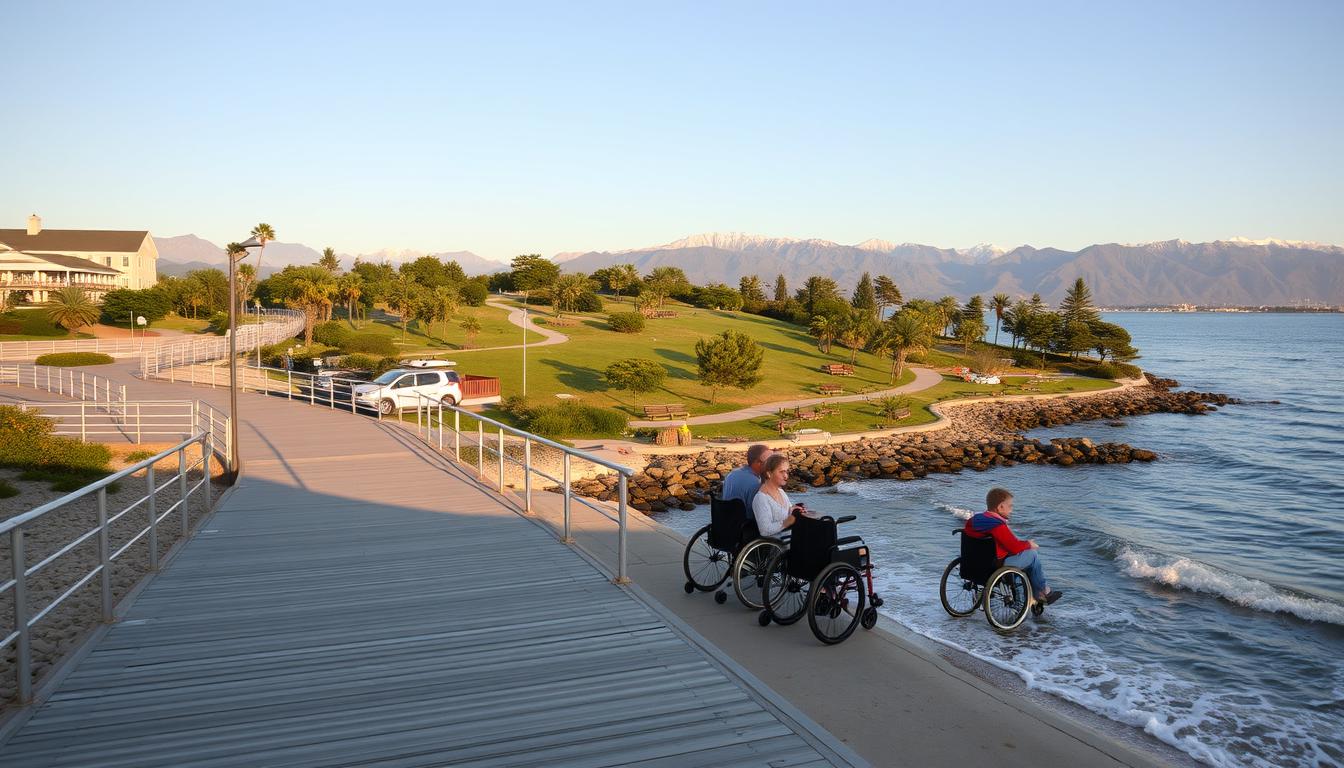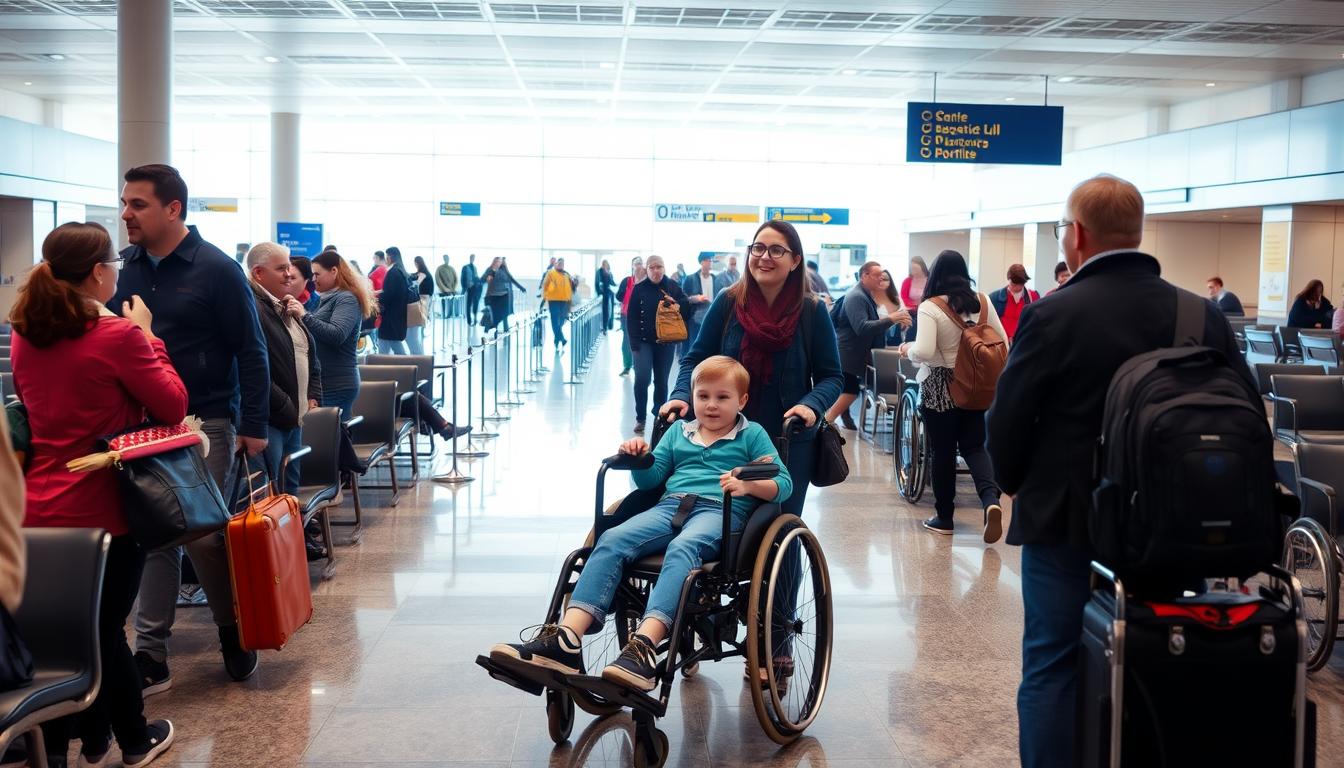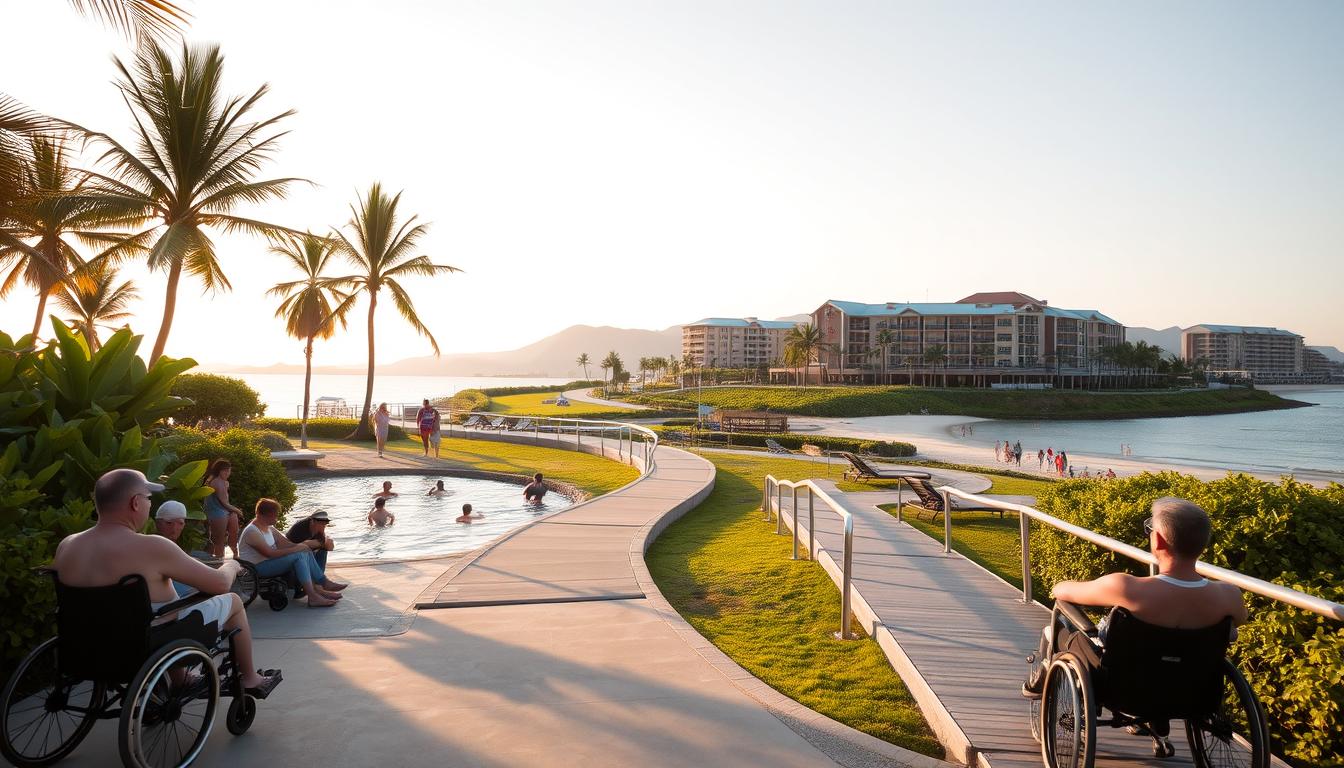Did you know millions of travelers with disabilities face big challenges when planning a trip? But, with the right help, you can have a stress-free and fun travel experience.
Planning a holiday as a traveler with unique needs can be tough. But, with the right tips and resources, you can make your trip great. Knowing your needs and picking the right places to stay are key.
By following good advice, you can have a hassle-free holiday that fits your needs. In this article, we’ll share valuable insights and practical tips for a great travel experience.
Key Takeaways
- Research accessible travel options before booking
- Understand your needs and plan according to them
- Choose accommodations that meet your needs
- Plan for transportation and mobility needs
- Stay informed about destination accessibility
Understanding Your Needs as a Disabled Traveler
Knowing what you need is the first step to a great trip. As a disabled traveler, you have special needs. These must be thought of to make your journey smooth and fun.
Assessing Accessibility Requirements
Start by thinking about what you need. This means looking at your mobility aid, like a wheelchair or walker. Also, find places that are easy to get to. Wheelchair-friendly vacations mean looking for spots that are accessible.
Identifying Support Systems
It’s important to know who can help you. This could be a friend, a caregiver, or local services at your destination. Knowing what help is out there can make your trip better.
Considering Health Needs
Your health is also key. Talk to your doctor before you go, if you have health needs. Make sure you have your meds and any special equipment you need. This keeps you safe and happy on your trip.
By thinking about what you need, who can help, and your health, you can plan a great trip. This careful planning is important for inclusive tourism. It lets you explore new places with confidence.
Researching Accessible Destinations
Finding a stress-free vacation starts with researching places that are easy to get around. You want your destination to meet your needs, making your trip enjoyable.
Top Accessible Cities in the U.S.
The U.S. has many cities working hard to be more accessible. Places like San Francisco, New York City, and Chicago are making big changes. They have wheelchair-friendly buses and trains, and places to visit that are easy to get to.
In San Francisco, the buses and trains have ramps and elevators. This makes it easier for people with mobility issues to explore the city. New York City also has a plan to make walking easier, with special signals and ramps at the curb.
Online Resources for Disabled Travelers
The internet is full of helpful sites for finding places to travel. Sites like Accessible Travel Solutions and Disabled Travelers Guide have lots of info. They include reviews and tips.
- Accessible Travel Solutions has guides on places around the world that are easy to visit.
- Disabled Travelers Guide has tips and resources for people with disabilities.
Reviews and Testimonials
Reading what others say is a great way to learn about a place. Sites like TripAdvisor have special sections for reviews from people with disabilities. These reviews can give you important insights.
For example, a review from someone who uses a wheelchair might talk about a hotel or attraction. This can help you decide where to go on your trip.
Finding the Right Transportation
As a disabled traveler, finding the right transportation is key for a stress-free holiday. Transportation is a big part of any trip. Knowing your options can make a big difference in your travel experience.
Accessible Air Travel Tips
Air travel can be tough for people with disabilities. But, many airlines now offer services to make it easier. When you book your flight, tell the airline about your needs.
Most airlines provide wheelchair assistance. Some even have special equipment for boarding. For example, some airlines let you pre-board. This gives you more time to settle before others board.
Choosing an airline with a good accessibility record can improve your flying experience. You can check transportation options between cities to plan better.
Key Air Travel Tips:
- Notify the airline about your disability when booking.
- Ask about wheelchair assistance and other accessibility services.
- Consider pre-boarding to make your boarding process smoother.
Train and Bus Accessibility
Trains and buses are also getting more accessible. Many trains have accessible seating and help for boarding and exiting. Some trains even have sleeper cars for longer trips.
For buses, some companies have lift-equipped buses or offer help for passengers with mobility issues. Always check with the bus or train service about their accessibility features when booking.
| Transport Mode | Accessibility Features |
|---|---|
| Air Travel | Wheelchair assistance, pre-boarding, accessible lavatories |
| Train Travel | Accessible seating, assistance for boarding/exiting, sleeper cars |
| Bus Travel | Lift-equipped buses, assistance for passengers with mobility challenges |
Rideshare Options for Disabled Travelers
Ridesharing is now a convenient travel option. Many rideshare companies offer accessible vehicles. But, availability can vary by location.
When using a rideshare service, check the app for accessible options. Also, tell the driver about your needs. Some companies offer extra help or services for travelers with disabilities.
Choosing Accommodations with Accessibility
Travelers with disabilities need places to stay that meet their needs. You have many choices, each with its own benefits.
Hotels vs. Vacation Rentals
Hotels and vacation rentals both offer accessible rooms. Hotels have many accessible rooms and services. They also have staff to help with various needs.
Vacation rentals offer more space and flexibility. This is great for travelers with companions or those needing extra equipment.
What to Look for in Accessible Rooms
When looking for an accessible room, check for these features:
- Wide doorways and hallways for easy movement
- Roll-in showers or bathtubs with grab bars
- Lowered counters and sinks
- Visual alarms and doorbells for hearing impairments
Reading reviews from other disabled travelers is also key. It helps you understand the accommodation’s accessibility.
Recommended Chains and Brands
Some hotel chains and brands focus on accessibility:
- Marriott: Offers accessible rooms and suites with roll-in showers and adjustable beds.
- Hilton: Provides a variety of accessible rooms and uses digital tools for guests with disabilities.
- Airbnb: Has many accessible vacation rentals. They offer filters to find the right place for you.
Think about what matters most to you and your travel needs. This way, you can have a wheelchair-friendly vacation that’s enjoyable and stress-free. It supports inclusive tourism.
Planning Activities and Excursions
Planning ahead can lead to a variety of activities and excursions for disabled travelers. This planning makes your trip better and lets you enjoy everything your destination offers.
Adaptive Tours and Experiences
Many tour operators have adaptive tours for travelers with disabilities. These tours include city walks and adventure activities with special accommodations.
- Look for tour operators that specialize in accessible travel.
- Check if guides are trained to assist disabled travelers.
- Read reviews from other disabled travelers to gauge the tour’s accessibility.
Navigating Outdoor Adventures
Outdoor adventures are exciting, with many places now having accessible trails and facilities. When planning outdoor activities, keep these tips in mind:
- Research parks and recreational areas that have accessible paths and amenities.
- Contact local park rangers or visitor centers for information on accessibility.
- Bring necessary mobility aids or equipment to ensure your participation.
Some popular outdoor activities for disabled travelers include: wheelchair-accessible hiking trails, adaptive kayaking or cycling programs, and accessible fishing piers.
Local Attractions with Accessibility
It’s important to check the accessibility of local attractions before visiting. Many museums, historical sites, and cultural landmarks have accessible entrances, restrooms, and exhibits.
- Check the attraction’s website for accessibility information.
- Call ahead to confirm accessibility features.
- Consider visiting during less busy times to have a more enjoyable experience.
By following these steps, you can have a fulfilling and enjoyable trip. You’ll take advantage of the many travel opportunities for disabled individuals available today.
Packing Essentials for Your Trip
Getting ready for your next adventure means packing the right things. This ensures a comfortable and fun trip. For those with mobility challenges, the right gear makes a big difference.
Mobility Aids and Their Considerations
For many, mobility aids are a must. Here are some tips for packing:
- Portable wheelchair chargers: Make sure your wheelchair is charged. Bring a portable charger for extra power.
- Travel-friendly walking aids: Choose lightweight, foldable aids that are easy to carry.
- Maintenance kits: Pack a small kit with basic tools for fixing your aids, like a multi-tool or spare parts.
Medical Supplies and Equipment
Keeping your health in check while traveling is key. Don’t forget to pack:
- Prescription medications: Bring enough for your trip and extra in case of delays. Keep them in their original packaging.
- Medical equipment: If you use equipment like oxygen tanks or CPAP machines, have a travel plan. This includes batteries or chargers.
- First aid kit: A basic kit should have band-aids, antiseptic wipes, and pain relievers.
Personal Items and Comforts
Personal items can make your trip more comfortable. Think about packing:
- Comfortable clothing: Pick clothes that are comfy for sitting or moving, based on your needs.
- Travel pillows or cushions: These offer support and comfort during long trips.
- Entertainment and distraction: Books, tablets, or other entertainment can be great during travel delays or downtime.
By packing these essentials, disabled travelers can have a more accessible and stress-free holiday. They can enjoy the trip without worrying about challenges.
Traveling with a Companion
Traveling with a friend can make your holiday better, even more for disabled travelers. It’s great to have someone to share the trip with. They can help, keep you safe, and make memories that last forever.
Benefits of Traveling Together
Traveling with a friend has many advantages, including:
- Enhanced Safety: Having a friend by your side can make you feel safer in new places or during emergencies.
- Shared Experiences: You can enjoy the trip together and make memories that you’ll always remember.
- Mutual Support: Friends can help with everyday tasks, give emotional support, and handle travel problems together.
Tips for Companion Care
When you travel with a friend, make sure both of you are happy and supported. Here are some tips:
- Communicate Needs: Tell your friend about your accessibility needs and what you like.
- Plan Together: Work together on planning to make sure you both like the itinerary.
- Share Responsibilities: Split tasks to make the trip easier and more fun for both of you.
Finding Travel Buddies: Resources
If you want to find a travel buddy, check out these resources:
| Resource | Description | Benefits |
|---|---|---|
| Disabled Travel Organizations | Many groups help disabled travelers with resources and forums. | Helps you meet others who travel like you and get travel tips. |
| Social Media Groups | Look for groups about accessible travel and disabled travelers. | It’s a place to meet travel friends and share your adventures. |
| Travel Forums | Online forums for travel are good for finding travel buddies. | You can post about your trip plans and find people who want to join you. |
Staying Safe While Traveling
Traveling with disabilities needs careful planning to stay safe. It’s important to prepare emergency plans and be aware of your surroundings. This way, you can enjoy travel opportunities for disabled individuals.
Emergency Plans and Contacts
Creating an emergency plan is key. You should have a list of important contacts. This includes your emergency services number, insurance provider, and a trusted friend or family member. Always leave a copy of your itinerary with your emergency contact.
Key elements of an emergency plan:
- Local emergency numbers
- Insurance information
- Contact details for your embassy (if traveling abroad)
- A list of your medications and dosages
Awareness of Surroundings
Knowing your surroundings is vital for safety. Research your destination to understand local customs and hazards. This knowledge helps you avoid risky situations.
Health Insurance Considerations
Understanding your health insurance is essential, even when traveling. Check if your policy covers you abroad and what it includes. This includes medical emergencies and evacuations.
| Insurance Provider | International Coverage | Emergency Evacuation |
|---|---|---|
| Provider A | Yes | Yes |
| Provider B | No | Yes |
| Provider C | Yes | No |
By taking these precautions, you can enjoy wheelchair-friendly vacations with peace of mind.
Communicating with Service Providers
Talking well with service providers is key to a great accessible travel trip. As someone with disabilities, it’s important to make sure your needs are understood and met. This is true for all the places you visit during your trip.
Disclosing Accessibility Needs
When you book flights, hotels, or tours, tell them about your accessibility requirements. Let airlines know if you need wheelchair help. Also, tell hotels about the need for an accessible room.
- Notify airlines about wheelchair requirements or special assistance needs.
- Inform hotels about the need for accessible rooms or other accommodations.
- Tell tour operators about any specific needs or requirements for tours and activities.
Tips for Clear Communication
Good communication is key when talking to service providers. Here are some tips to make sure your needs are understood:
- Be specific about your accessibility needs.
- Use clear and simple language to avoid misunderstandings.
- Confirm that your requests have been understood and noted by the service provider.
- Keep a record of your communications, including dates, times, and details of what was discussed.
Advocating for Yourself
As a disabled traveler, speaking up for yourself is important. Don’t be shy to ask for what you need or to clarify any doubts.
| Service Provider | Information to Disclose | Tips for Communication |
|---|---|---|
| Airlines | Wheelchair assistance, special seating needs | Notify in advance, confirm booking details |
| Hotels | Accessible rooms, special equipment needs | Request specific accommodations, verify booking |
| Tour Operators | Accessibility needs for tours and activities | Inform in advance, ask about accessibility features |
By talking well with service providers, you can make your mobility challenges holiday better. This way, your needs are met, and you can enjoy your trip without stress.
Utilizing Technology to Enhance Your Experience
Technology can change the game for disabled travelers. It offers access to services and info tailored to your needs. With the right tools, your travel can be more fun and less stressful.
Apps for Accessible Travel
Many apps help make travel easier for people with disabilities. For example, Wheelmap and AccessNow show if places are accessible. This helps you plan trips knowing where to go.
Apps like Google Maps and Apple Maps also help. They show wheelchair-friendly paths. This makes it easier to get around new places.
Online Communities and Support Groups
Online groups are key for disabled travelers. Sites like Facebook Groups and Reddit connect you with others. You can share tips and learn about inclusive tourism.
These groups offer real advice on traveling. You’ll learn about places that welcome everyone. It’s great for planning trips.
Navigation Tools for Disabled Travelers
Navigation is key for travel. There are tools made just for disabled travelers. GPS apps give info on accessible paths and places nearby.
Some apps even have audio for the blind. This makes traveling better for everyone. Wearable tech and smart canes are also coming. They help with navigation, making it easier to get around.
Budgeting for Accessible Travel
Planning a budget for accessible travel means knowing what to expect and how to save. As someone with a disability, you face unique costs. These include special transportation, rooms with the right facilities, and medical gear.
Understanding Costs for Accessibility
Accessibility costs can change a lot based on where you go and what you need. For example, wheelchair-friendly vacations might mean paying more for hotels with accessible rooms. It’s key to look into these costs early to manage your budget well.
- Research accessible transportation options and their costs.
- Book accommodations that offer accessible facilities.
- Consider the cost of medical equipment and supplies.
Finding Discounts and Grants
There are ways to cut down on the costs of accessible travel. Many groups offer discounts and grants for disabled travelers. Some disability advocacy groups help with travel costs.
- Look for travel agencies that specialize in accessible travel and offer discounts.
- Apply for grants from organizations that support disabled travelers.
- Utilize travel rewards programs if you have associated credit cards or memberships.
Tips to Save on Travel Expenses
To save on travel, you need to plan and be flexible. Traveling during the off-season can lower costs for places to stay and get around. Also, look for package deals that include things to do and how to get there.
- Be flexible with your travel dates to take advantage of lower prices.
- Book your travel and accommodations well in advance to secure better rates.
- Research free or low-cost accessible activities at your destination.
By knowing the costs of accessible travel, finding discounts and grants, and using smart saving tips, you can have a more affordable and enjoyable trip.
Sharing Your Travel Experiences
When you return from your travels, sharing your stories is very helpful. Your experiences can help others plan their trips better. They can also encourage businesses to make their places more accessible.
Writing Reviews and Feedback
Writing reviews is a great way to share your travel stories. When you write a review, talk about the accessibility you found. This includes wheelchair ramps, accessible restrooms, and Braille signage. Your feedback helps others know what to expect and make better choices.
If you stayed at a hotel with great accessibility, mention it in your review. This can encourage others to choose that hotel. On the other hand, if you faced challenges, sharing your experience can help the hotel improve.
Connecting with Other Travelers
Meeting other travelers with similar needs is rewarding. Join online forums or social media groups for accessible travel. You can share tips on accessible destinations, transportation options, and accommodations.
These connections can lead to new friendships and travel buddies. Sharing experiences with others who get your needs can make your travels more enjoyable. It also gives you a support network.
Influence of Social Media on Accessibility
Social media plays a big role in promoting accessible travel. By sharing your experiences on platforms like Facebook, Twitter, or Instagram, you can highlight disability-friendly holiday destinations. This encourages businesses to improve their accessibility.
Using hashtags related to accessible travel can make your posts more visible. You can also follow and engage with organizations that support disability rights and accessible travel. This helps spread their messages and efforts.
| Platform | Use for Accessible Travel | Benefits |
|---|---|---|
| Joining groups, sharing experiences | Community building, information sharing | |
| Using hashtags, posting updates | Real-time engagement, awareness raising | |
| Sharing photos, stories | Visual inspiration, community engagement |
By sharing your travel experiences through reviews, connections, and social media, you help make travel more inclusive. Your stories and feedback are very valuable. They promote accessible travel and improve the travel experience for everyone.
Reflecting on Your Travel Experiences
When you get back from your trip, thinking about it can be really helpful. You can figure out what went well and what didn’t. This helps you plan better for your next trip.
Lessons Learned
Think about what you enjoyed most and what was tough. This helps you learn for the next time. It makes traveling more fun and easy for everyone.
Future Trip Planning
Use what you learned to plan your next trip. Think about how to make it better and more enjoyable. This way, your next adventure will be even more special.
Staying Connected
Keep in touch with the people and places you met. Sharing your stories helps others. It also keeps you connected for future travels.




